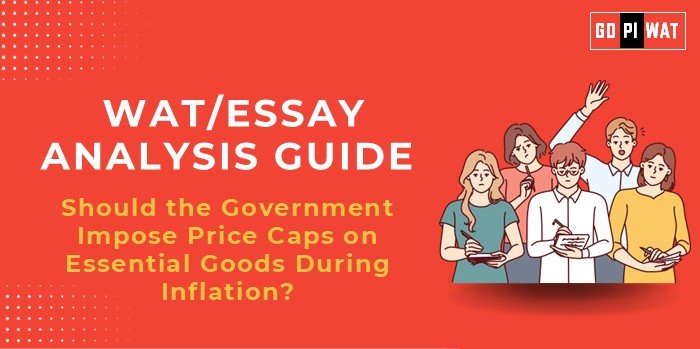📋 WAT/Essay Analysis Guide
Topic: Should the government impose price caps on essential goods during inflation?
🌟 Understanding the Topic’s Importance
Price caps on essential goods during inflation is a critical topic that merges economics, public policy, and governance. It highlights the challenge of balancing short-term relief for consumers with long-term market stability, making it particularly relevant for B-school students interested in policy analysis, operations, or macroeconomics.
⏱️ Effective Planning and Writing
- Time Allocation:
- 📝 Planning: 5 minutes
- ✍️ Writing: 20 minutes
- 🔍 Reviewing: 5 minutes
- Preparation Tips:
- Identify key statistics (e.g., inflation rates, examples of price caps).
- Note relevant stakeholders and their implications.
💡 Introduction Techniques
- Contrast Approach:
“While price caps offer immediate relief from inflation for consumers, they can create long-term inefficiencies such as supply shortages and hoarding. This trade-off presents a policy conundrum for governments aiming to balance affordability with market stability.”
- Solution-Based:
“A holistic approach to inflation control, combining price caps, subsidies, and digital monitoring, can address both consumer needs and market dynamics.”
📊 Structuring the Essay Body
🏆 Achievements
- 📜 Policy Impact: Price caps can prevent inflation from exacerbating economic inequality.
- 📈 Example: India’s onion price cap in 2023 reduced inflationary pressures by 15% within two weeks, protecting millions of households from soaring costs.
⚠️ Challenges
- 📉 Market Distortions: Price caps can lead to unintended consequences such as black markets and supply shortages.
- 🌍 Example: Zimbabwe’s strict price controls in 2021 fostered black market activity, undermining their effectiveness.
- 🔄 Implementation Issues: Without complementary measures like subsidies or enhanced supply chain management, price caps can fail to achieve their objectives.
🚀 Future Outlook
- 💡 Digitizing Supply Chains: Use digital tools to monitor supply chains and ensure smooth operations.
- 🤝 Targeted Subsidies: Provide financial support to producers to mitigate supply disruptions.
- 🌍 Global Best Practices: Learn from France’s ‘Anti-Inflation Basket,’ which balances affordability with market stability.
📄 Concluding Effectively
- Balanced Conclusion:
“While price caps provide necessary relief during inflationary periods, their success depends on robust implementation and complementary measures. Policymakers must prioritize long-term solutions over short-term fixes to ensure market stability and consumer welfare.”
- Global Reference Conclusion:
“Drawing lessons from global examples like France and Singapore, India can refine its approach to price caps, leveraging technology and targeted subsidies to mitigate inflation without disrupting markets.”
✍️ Sample Short Essays
- Balanced Perspective:
“Price caps are a double-edged sword: while they ensure affordability during inflation, their misuse can disrupt markets. Complementary policies, such as subsidies and digital supply monitoring, are essential to balance affordability with efficiency.”
- Solution-Oriented:
“Governments should adopt a holistic strategy combining price caps, subsidies, and technology-driven monitoring to mitigate inflationary pressures effectively, safeguarding both consumers and market dynamics.”
- Global Comparison:
“Countries like France have shown that price caps, when paired with targeted subsidies, can curb inflation while maintaining market balance. India can emulate such practices to manage inflation more sustainably.”
🌟 Recommendations for Sustainable Progress
- 📊 Integrate Technology: Use digital tools to monitor supply chains and prevent hoarding or black market activity.
- 📈 Implement Targeted Subsidies: Provide financial support to producers and ensure vulnerable populations benefit without harming market dynamics.
- 🌍 Adopt Global Best Practices: Learn from successful models like France’s subsidized price caps and Singapore’s balanced inflation policies.


